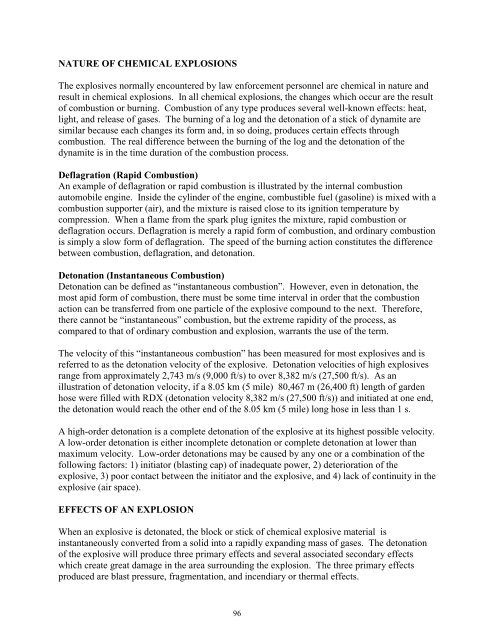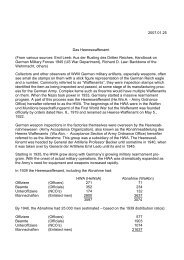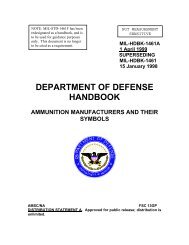Explosives-Nature, Use, Effects and Application.pdf
Explosives-Nature, Use, Effects and Application.pdf
Explosives-Nature, Use, Effects and Application.pdf
Create successful ePaper yourself
Turn your PDF publications into a flip-book with our unique Google optimized e-Paper software.
NATURE OF CHEMICAL EXPLOSIONS<br />
The explosives normally encountered by law enforcement personnel are chemical in nature <strong>and</strong><br />
result in chemical explosions. In all chemical explosions, the changes which occur are the result<br />
of combustion or burning. Combustion of any type produces several well-known effects: heat,<br />
light, <strong>and</strong> release of gases. The burning of a log <strong>and</strong> the detonation of a stick of dynamite are<br />
similar because each changes its form <strong>and</strong>, in so doing, produces certain effects through<br />
combustion. The real difference between the burning of the log <strong>and</strong> the detonation of the<br />
dynamite is in the time duration of the combustion process.<br />
Deflagration (Rapid Combustion)<br />
An example of deflagration or rapid combustion is illustrated by the internal combustion<br />
automobile engine. Inside the cylinder of the engine, combustible fuel (gasoline) is mixed with a<br />
combustion supporter (air), <strong>and</strong> the mixture is raised close to its ignition temperature by<br />
compression. When a flame from the spark plug ignites the mixture, rapid combustion or<br />
deflagration occurs. Deflagration is merely a rapid form of combustion, <strong>and</strong> ordinary combustion<br />
is simply a slow form of deflagration. The speed of the burning action constitutes the difference<br />
between combustion, deflagration, <strong>and</strong> detonation.<br />
Detonation (Instantaneous Combustion)<br />
Detonation can be defined as “instantaneous combustion”. However, even in detonation, the<br />
most apid form of combustion, there must be some time interval in order that the combustion<br />
action can be transferred from one particle of the explosive compound to the next. Therefore,<br />
there cannot be “instantaneous” combustion, but the extreme rapidity of the process, as<br />
compared to that of ordinary combustion <strong>and</strong> explosion, warrants the use of the term.<br />
The velocity of this “instantaneous combustion” has been measured for most explosives <strong>and</strong> is<br />
referred to as the detonation velocity of the explosive. Detonation velocities of high explosives<br />
range from approximately 2,743 m/s (9,000 ft/s) to over 8,382 m/s (27,500 ft/s). As an<br />
illustration of detonation velocity, if a 8.05 km (5 mile) 80,467 m (26,400 ft) length of garden<br />
hose were filled with RDX (detonation velocity 8,382 m/s (27,500 ft/s)) <strong>and</strong> initiated at one end,<br />
the detonation would reach the other end of the 8.05 km (5 mile) long hose in less than 1 s.<br />
A high-order detonation is a complete detonation of the explosive at its highest possible velocity.<br />
A low-order detonation is either incomplete detonation or complete detonation at lower than<br />
maximum velocity. Low-order detonations may be caused by any one or a combination of the<br />
following factors: 1) initiator (blasting cap) of inadequate power, 2) deterioration of the<br />
explosive, 3) poor contact between the initiator <strong>and</strong> the explosive, <strong>and</strong> 4) lack of continuity in the<br />
explosive (air space).<br />
EFFECTS OF AN EXPLOSION<br />
When an explosive is detonated, the block or stick of chemical explosive material is<br />
instantaneously converted from a solid into a rapidly exp<strong>and</strong>ing mass of gases. The detonation<br />
of the explosive will produce three primary effects <strong>and</strong> several associated secondary effects<br />
which create great damage in the area surrounding the explosion. The three primary effects<br />
produced are blast pressure, fragmentation, <strong>and</strong> incendiary or thermal effects.<br />
96




